welcome to cathode ray dude's blog. please be aware that i'm a lot cruder on here than on youtube.
you can subscribe via RSS. point your reader here: RSS Feed
three useless phones
today i bought three phones which are completely useless. i didn't know that at the time but i probably would have bought them anyway if i had.
read more
i'm obviously on a flip phone kick rn, so i've been searching the local ewaste (pronounced “eh-wah-stay”) for Curiously Late Model devices. i actually have a terrific specimen already, an Ericsson Z750 that's been doing a lot of good for me - it's funny actually, i've been using it so much that it's starting to feel like My Phone, like it belongs in my pocket and i feel kind of weird if it isn't. 2007 is calling. no pun intended. but i could use more.
obviously if i'm gonna take a serious look at flip phones, i need variety. i should get at least one “candybar,” i should get a couple different resolutions, i should find one with just an obnoxiously fast processor from the late days of the classic featurephone era (like 09,) i should find one of the pre-android touchscreen types (since there are J2ME games with touch support!) and i should find one of the few with landscape screens and built in keyboards. this'll take a while.
today i went looking and came up with these three, none of which contribute to the aforementioned bottom line. none of these phones run J2ME. in fact, probably none of them will ever do anything useful again, but they're still intriguing specimens.
from left to right, we have the Alcatel 40440, the ZTE Z233VL, and the Kyocera DuraXV e4520.
at a glance, the first two look suspiciously modern; the screens are enormous (it turns out flip phone screens are… smaller than I remember) and the keypads are very plain. the first one in particular looks almost like material design in physical form, utterly no nonsense, just big honking plain rectangles and simple geometric symbols. the middle one is a bit rounder and puffier, but the enormous, ultra-clear icons on the special buttons above the dialpad betray modern “clean” design sensibilities that simply didn't exist in the 2000s. the third one looks a bit more dated, which will actually end up being ironic in the end.
when we look at the menus, again, the kyocera looks right at home in 2004 or so, but the other two are immediately, violently out of place. the one in the middle in particular: those are android icons.
weirdness level: 1
and sure enough, it is android. or, well… close? apparently this is a ZTE fork they call Zdroid, and i can't find much info on it. one redditor says it's a heavily customized version of 8.1 (per the ZTE open source compliance site) that they modified to support touchless operation. that seems truthy but it's all i can find so who knows.
developer mode is disabled, it won't open APKs, it has no wifi (incredibly weird to see on an android device!) and since i have no SIM for it and USB tethering has been removed, there's no way to get this thing online. not that it matters, because there doesn't seem to be a store - i don't think it was ever possible to add apps to this thing, which kinda makes sense. i get the impression that it was sold as an ultra cheap entry level device (mine was made under contract for TracFone) and you were expected to upgrade to a better gadget if you wanted access to all of god's kingdom.
i bought this because i wanted very badly to have an android flip phone in my collection. what a strange concept. i believe this is actually a dead lineage, and that other vendors are offering flip phones with a much more normal, actual-android OS to this day; i need to look into it further, because $20 or $40 would be a reasonable price to pay to see what that's like.
as weird as this is though, it doesn't hold a candle to the Alcatel.
weirdness level: 2
“what,” you might be saying, “the fuck is KaiOS?”
or more likely you're saying “ah okay it's yet another CompanyNameOS that's not an OS at all, but just a shitty reskin of android.”
but that's where you'd be wrong, and where i was wrong, and where everyone would be wrong because this is motherfucking
FIREFOX OS.
that's right. remember when mozilla tried to make an android competitor back in 2014 and literally everyone ignored it? no, you don't remember that, because it was a flash in the pan that nobody remembers? yeah me too actually. i only vaguely remembered that this thing existed, and that it was considered a joke, and then it went away.
i read a post on hackernews (sorry) which linked a post on medium; combining the two, it seems that the basic order of events there was,
- mozilla comes up with an android competitor where the gimmick is that the entire OS, every single pixel you see, is rendered by gecko. whole OS is a single browser window. all apps are just webapps in a zip file.
- mozilla works on this for a couple years, then shops it to phone vendors. absolutely nobody is interested, and it's obvious the project is a failure
- as the whole thing is grinding to a halt, market analysts notice that there's actually a massive and underserved market in a few places like india, where the phones people can afford cannot run android. it is clearly possible to make firefox os serve this market. an attempt is made.
- the attempt fails; the phone is too expensive and too slow. mozilla could fix this, but they fail to respond quickly and effectively and the whole thing falls apart, especially because,
- it won't run WhatsApp.
you can't sell a phone in india that doesn't run whatsapp, and apparently they refused to port it to firefox because it was this nothing-OS that nobody had heard of. naturally mozilla couldn't change that without selling a billion phones, which they couldn't do without whatsapp. a real pickle.
according to a poster on HN, mozilla's last-ditch effort to save firefoxOS was to try to get it to run WhatsApp without any help from the company, and their route to achieving this was… adding J2ME support. because apparently the big secret of WhatsApp's success, the thing that perennially baffles all us rich westerners, is that it wasn't just a smartphone app - you could use it on flip phones too.
mozilla's hail mary pass apparently failed however; they did not get WhatsApp J2ME working, and FirefoxOS did not take off in india or anywhere else. shortly thereafter the project was cancelled and many people were fired, but a lot were apparently poached by a company called KaiOS Technologies. they took the FirefoxOS source, chopped out everything that wouldn't fit in a $30 phone, and made the thing Mozilla should have made. this worked perfectly.
per wikipedia:
In market share study results announced in May 2018, KaiOS beat Apple's iOS for second place in India, while Android dominates with 71%, albeit down by 9%. KaiOS growth is being largely attributed to the popularity of the competitively-priced JioPhone. In Q1 2018, 23 million KaiOS devices were produced.
In March 2020, Mozilla and KaiOS Technologies announced a partnership to update KaiOS with a modern version of the Gecko browser engine, and more closely aligned testing infrastructure. This change should give KaiOS four years worth of performance and security improvements and new features.
the article also claims the latest release was last year. that might suggest its popularity is winding down, but given the limited functionality of these devices, maybe yearly-at-best updates are actually the norm.
going back to the phone in question: what's really intriguing is that this thing was sold here, in the US. don't get me wrong, you can buy and (apparently) use brand new KaiOS phones in the US, but i don't think any carriers offer them, even ones like tracfone, presumably because subsidies here are so generous that you can just get a $100 android phone for essentially free. all the KaiOS phones out there are dirt cheap, and in fact all seem to use the Snapdragon 210, a cheap-as-hell SoC from 2015 which I think has been the backbone of KaiOS devices forever.
it's what's in my alcatel as well, in fact. but the remarkable thing is that it's not branded as an Alcatel: it's OEMed to AT&T, that's the only logo you'll find on it (unless you pry off the back cover and look at the battery,) but for some inscrutable reason, AT&T themselves brand it under… Cingular???????????
no, the cingular brand has not been resurrected; i checked. AT&T has used it for nothing since killing it in 2007… except this. the “AT&T Cingular Flip”, and flip 2, 3, 4 and flex were all very similar kaios phones, and as far as i can tell the only things to use the cingular brand. what on earth was this about? i have no idea. i am raising my hands in a gesture of helplessness; i cannot help you.
i think i'm probably forgetting a few observations i wanted to write here, because a bug in ckgedit made me lose half this post three times before i got fed up and hacked doku's draft code to save constant backups. ah, right, here's something: there's no app store. from what i understand kaios is supposed to have a “big” app store, so the lack here is glaring. on the other hand, most kaios phones seem to be touch based, so perhaps the apps are all designed for that? maybe the store was disabled in the US because the market was so small that none of the software was likely to be translated or updated for it? not sure
one feature that makes sense but is extremely weird to see in a flip phone is wifi. it works just fine, and why wouldn't it? the phone has a snapdragon 210, i'm sure those have built in wifi. in fact, it just makes it even weirder that the ZTE android flip phone didn't have it, though i'm not 100% sure which SoC is in that. consequently though, i was able to easily verify which browser it's using:
it was amazing that this thing just got online with no complaints. i guess it probably has relatively recent TLS support and certs, having come out in at least 2017 (based on the release date of KaiOS 1.0.) that said, firefox 37 came out in 2015, so… was it super outdated, were the version numbers inconsistent vs. desktop, or do i have my dates wrong? couldn't say.
the way the browser works is interesting. as soon as it starts, a mouse cursor appears. this is not an underlying OS showing through or anything like that - remember, this is a native phone OS, afaik it was never derived from anything desktop-oriented. i believe the browser is drawing this itself, because there's no touchscreen and no mouse, so you steer this pointer from element to element with the D-pad, and it snaps to each one; I don't know if there's a mode where you can move the cursor freely.
this works… fine. as you can see the resolution of the screen leaves a lot to be desired, though it does start at a pretty high zoom level as well and decreasing that helps. it's also sluggish; you wouldn't want to do a ton of web browsing on this. but it's certainly no “3g flip phone from 2003” browser; it's just normal firefox, so any page that will fit in memory i assume is going to render and work just fine.
one last observation: i'm sure this is just a US rebrand of a phone originally targeted at various east asian markets, most likely including china, so…
…is it even remotely surprising that it has an FM radio?
idk if radio is Just That Popular in china or if it's simply that they have quadrillions of FM receiver modules that cost a tenth of a penny, thus letting manufacturers stick one more meaningless bullet point on the feature list, but either way this is a nearly universal feature in chinese domestic market products; you actually find FM radios shoved into things much stranger than phones, but i'm pretty sure every domestic market phone has one.
naturally there isn't room for a reasonable FM antenna though, and this is solved the same way it always is in this kind of device: by using the cable on a pair of headphones as the antenna. consequently, when you launch the radio app, it outright refuses to operate until you plug in headphones - something my sony ericsson j2me phone also does, except it requires a proprietary headset that i don't have, so i haven't even been able to test it.
the alcatel simply takes a 3.5mm plug, so i hooked up my Sennheiser HD660S and was consequently treated to the nicest radio experience of my life. it picked up the local NPR station immediately, there was some soft jazz playing, and it just sounded absolutely phenomenal. i mean those headphones work a lot of magic on their own, but the phone was driving them pretty well and getting a super clear signal, so i gotta give it some credit. it also continues operating when you leave the radio app, so if you were out and about you could absolutely use this as just, you know, a pocket radio. there's nothing to complain about except, i guess, that it can't record; we can guess why that is, particularly for the US model.
technically i could probably come up with more things to say about this phone but i'd just be fisking it at that point, reviewing every little pixel, so let's move on to the final entry.
weirdness level: honestly its back to 1 again tbh
after all that, the kyocera is almost a letdown. it's pretty much just a ruggedized flip phone with a PTT button, you know the sort, nextel sold a billion of them. unlike the other specimens we've been looking at, this isn't some kind of Thing That Should Not Be - the sort of thing it is was by no means rare in its day. well. if it had been made during its day.

the kyocera runs Brew MP. short for Binary Runtime Environment for Wireless, BREW was the primary competition (supposedly) with J2ME in its heydey. as the name suggests, BREW apps used native code, which theoretically means they ran faster due to the lack of a VM between them and the bare metal. there's a lot i don't know about BREW. did it demand a specific architecture, or were devs expected to cross compile tons of variants of each app? was it actually faster, did anyone ever try benchmarking it? and many other questions that are hardly even worth asking since, as it turns out, i will probably never get to see any of it in action.
i was excited when i stumbled on this phone. i had found about a dozen J2ME devices but didn't really expect to encounter BREW unless i went looking for it specifically. then i fired this thing up and presto, there it was! i bought it for a few bucks, took it home, went looking for an archive of BREW apps… and didn't get nearly the results i expected. oh sure, they're out there, but only in the form of a couple big zipfiles on internet archive (which is down again, sigh) and one huge zip on mega. J2ME on the other hand had, and continues to have, something like eight different piracy sites, with contents categorized and sorted meticulously by target platform and screen size. what's going on here?
well, as it turns out, there wasn't much of a piracy scene for BREW. part of this, to be crass, is probably because of its market: from what i've read it was almost exclusively a US phenomenon, and while not all 2000s-era american cellphone-havers were wealthy, probably very few were broke enough to be interested in pirating games that cost $2-3. J2ME on the other hand was massive in europe, including a number of fairly impoverished countries where piracy was rampant. virtually all the J2ME piracy sites are russian, and indeed, there continues to be an enormous community of mobile device hackers in russia who spend all their time jailbreaking every imaginable low-cost gadget, smart or dumb. xdadevelopers still has people hacking windows mobile devices.
it's kind of ironic that J2ME was the standard in these places, because it is the most easily pirated thing in existence. no attempt at DRM was made: every game is simply a JAR file, and many phones would let you simply copy anything you downloaded to a memory card, or in some cases just beam it over bluetooth. of the J2ME phones I've played with, all of them have been quite happy to simply install any JAR i beamed to them, or selected from a memory card.
BREW, on the other hand, is DRMed straight up the asshole. if what i've read is to be believed,
- no BREW phone has any mechanism for installing software from a filesystem. all apps must be delivered through a carrier store.
- everything you download is tagged with a device-specific key
- even if you somehow manage to get the files into the phone's filesystem, it will refuse to run them
- this has been jailbroken on a total of like, 4 phones, and the kyocera is not one of them
in other words, i'm screwed. with the carrier store gone, this phone will never, ever run a BREW app again, and that's all there is to it. chances are i will never find a phone that can be sideloaded either, so BREW is probably just off the table.
though, that first point is interesting - because maybe the carrier store isn't gone? i don't have a way to check, since i can't get it on a network, but since this phone came out in 2015, i guess maybe the store COULD still exist? but coming out that late, long after the smartphone revolution, would the store even have contained anything other than, like, verizon's shitty GPS app? probably not! who knows!
it's interesting that this phone even came out in 2015. sure, it has the PTT feature, but i believe that eventually got rolled into android phones. i suspect that hadn't happened yet though - this was probably just an extension of the problem that created kaiOS, that android was still too heavy for low cost devices.
and… that's it! three pretty much useless phones. i mean, i guess they'd probably make calls and send texts, but i will not be doing that with any of them, ever, and probably there are better options even if you wanted to.
![[H] cathode ray dude's blog](/lib/exe/fetch.php?media=wiki:logo.png)
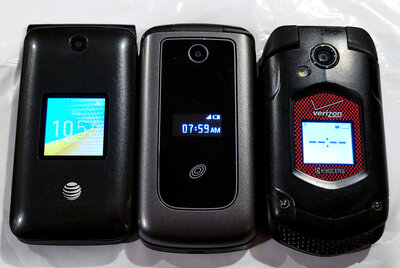
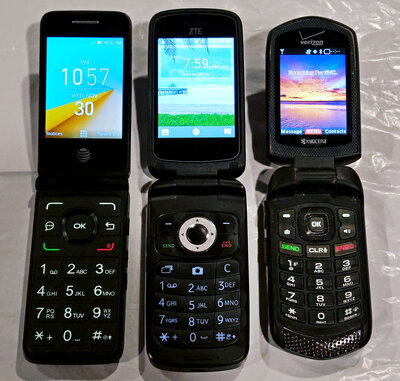
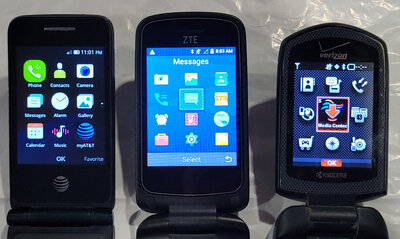
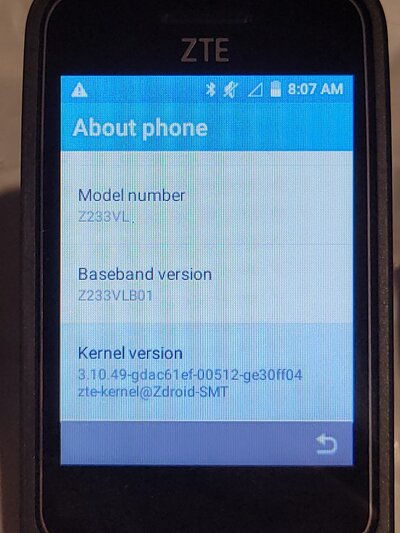
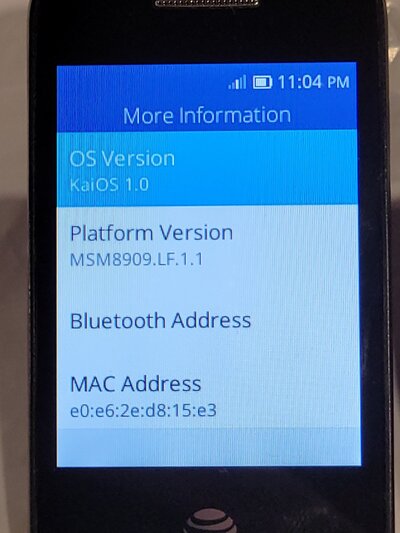
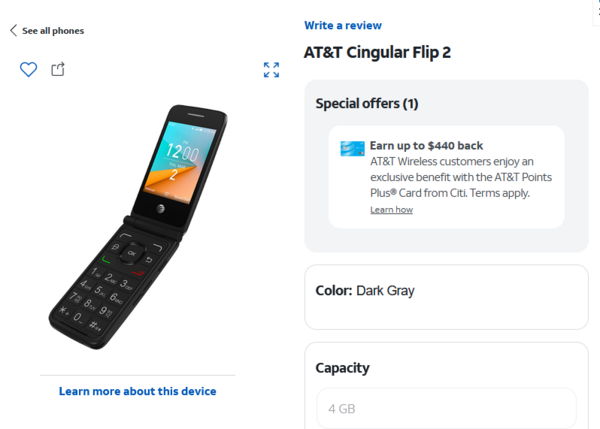
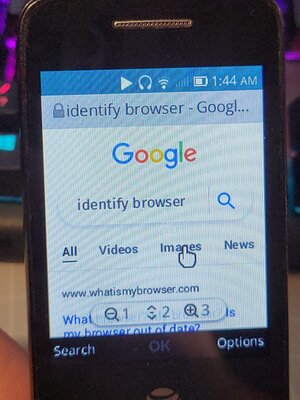
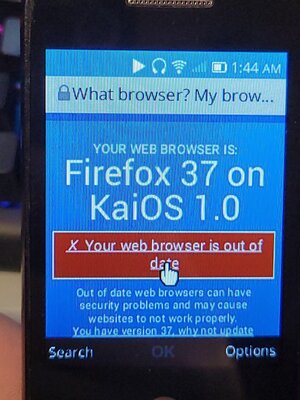
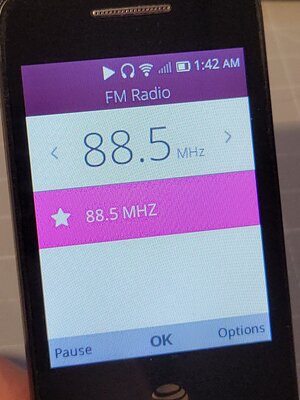
Discussion
OK so fun thing, the… TCL Flip Go, Walmart Family Mobile thing, it's like what, $24 from the Walmart in Renton? *that* runs Android. Just…….android. If you type, like, *#33284#*#* or something it'll enable adb, it has wifi and 4g, you can sideload whatever apps you want on it. 1.5GB of ram, 8GB of storage, MicroSD, terrible terrible terrible camera, USB C, 1.5GHz Mediatek something. We uh, we ran discord on it at one point.
oh god, BREW. I'm pretty sure my verizon LG chocolate was BREW and it was indeed a terrible experience – and something I didn't want to use very much because I was a young teen with no income of my own and everything seemed like if you tried to do something you would get charged for it. bad times all around.
i actually “used” a firefox phone briefly! it was the LG Fx0, and it was made for the japanese market. it's a gorgeous little phone, and there's even an english fansite for it… somewhere. i got it back when they were on super clearance on amazon of all places for like 50$. this was back when i was kind of an android holdout, and my daily driver was a nokia n9 (hell yeah meego)
anyway, unless you were able and willing to use dodgy cracked vendor firmware tools, it was locked to japanese LTE bands, so data beyond 3g was a no go over here. there were a couple of firefoxos variants for the device, and both were charming and annoying in their own special ways. i absolutely adored the emoji set. you still see the fox emojis it came with scattered across the fediverse here and there
eventually, i ended up installing an android cm11 image on the thing and used it as my primary mp3 player until very recently. kinda wish i'd backed up some of the system partitions beforehand, though, as there isn't really an easy road back to ffos on the device anymore (whoops)
a final note – if you want to go down the kaios rabbit hole more and you haven't stumbled into it already on your own, you may want to check out bananahackers
I've bought a few recent flip phones in the past couple years, curious what they were about, but found them pretty much impractical for actual daily use (shocking, I'm sure). I've got the Cat S22 Flip (runs Android 11) and the T-Mobile Go Flip (Kai OS). The version of KaiOS on the Go Flip is, I'm pretty sure, a newer - or certainly a more full-featured - version than the one in your post here, and includes the KaiOS store as well as YouTube apps and a severely nerfed version of Google Assistant. That one honestly works better as a daily driver than the Cat S22 Flip does - Android just isn't meant for a flip phone, and any amount of work an OEM would put in would never be enough.
I was vaguely aware that the whole Firefox/KaiOS thing was happening because I was very, very faintly interested to see if it would ever become webOS in spirit. It clearly did not. It became something arguably more interesting, I suppose.
oh, regarding Cingular: AT&T likely just doesn't want the trademark to expire, so they have to use it on something, and so they stuck it temporarily on the least visible thing they could that probably would continue untouched for years just to kick the can down the road.
ugh i remember using an awful BREW navigation app for like $3 for the day because I was lost as fuck. I don't think I bought any games from Verizon's shitty store.